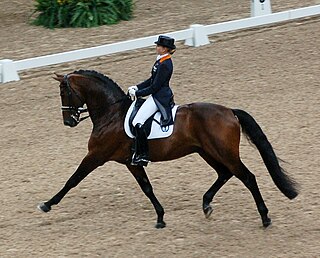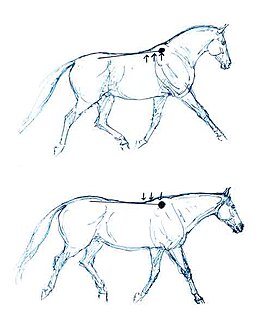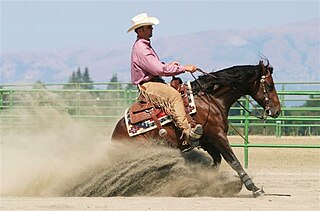
Dressage is a form of horse riding performed in exhibition and competition, as well as an art sometimes pursued solely for the sake of mastery. As an equestrian sport defined by the International Equestrian Federation, dressage is described as "the highest expression of horse training" where "horse and rider are expected to perform from memory a series of predetermined movements."

Horses can use various gaits during locomotion across solid ground, either naturally or as a result of specialized training by humans.

Collection occurs when a horse's center of gravity is shifted backwards. Energy is directed in a more horizontal trajectory with less forward movement. Biomechanical markers include: increased flexion in the lumbo-sacral joint, stifle, and hocks of the horse; increased engagement of the thoracic sling muscles resulting in the withers rising relative to the horse's scapula; and reduced ranges of limb protraction–retraction.

Reining is a western riding competition for horses where the riders guide the horses through a precise pattern of circles, spins, and stops. Reining is also considered to be a lot like figure skating. All work is done at the lope, or the gallop. Originating from working cattle, reining is often described as a Western form of dressage riding, as it requires the horse to be responsive and in tune with its rider, whose aids should not be easily seen, and judges the horse on its ability to perform a set pattern of movements. The horse should be willingly guided or controlled with little or no apparent resistance and dictated to completely. A horse that pins his ears, conveying a threat to his rider, refuses to go forward, runs sideways, bounces his rear, wrings his tail in irritation or displays an overall poor attitude is not being guided willingly, and is judged accordingly.

The trot is a two-beat diagonal horse gait where the diagonal pairs of legs move forward at the same time with a moment of suspension between each beat. It has a wide variation in possible speeds, but averages about 13 kilometres per hour (8.1 mph). A very slow trot is sometimes referred to as a jog. An extremely fast trot has no special name, but in harness racing, the trot of a Standardbred is faster than the gallop of the average non-racehorse, and has been clocked at over 30 miles per hour (48 km/h).

The canter and gallop are variations on the fastest gait that can be performed by a horse or other equine. The canter is a controlled three-beat gait, while the gallop is a faster, four-beat variation of the same gait. It is a natural gait possessed by all horses, faster than most horses' trot, or ambling gaits. The gallop is the fastest gait of the horse, averaging about 40 to 48 kilometres per hour. The speed of the canter varies between 16 to 27 kilometres per hour depending on the length of the horse's stride. A variation of the canter, seen in western riding, is called a lope, and is generally quite slow, no more than 13–19 kilometres per hour (8–12 mph).

The half-pass is a lateral movement seen in dressage, in which the horse moves forward and sideways at the same time. Unlike the easier leg-yield, the horse is bent in the direction of travel, slightly around the rider's inside leg. The outside hind and forelegs should cross over the inside legs, with the horse's body parallel to the arena wall and his forehand leading. The horse should remain forward, balanced, and bent, moving with cadence. The inside hind leg remains engaged throughout the half-pass, and the horse should not lose its rhythm.

Rollkur or hyperflexion of the horse's neck is an illegal practice in equestrianism defined as "flexion of the horse's neck achieved through aggressive force" and is banned by the world governing body, the International Federation for Equestrian Sports (FEI). The FEI recognises a distinction between rollkur and the riding of the horse in a deep outline not achieved by force.

A "baucher" is also a type of bit, named after the man.

Riding figures are prescribed paths a horse is ridden on in a riding arena, usually for training purposes. Figures may also be performed out in a field or other open area, but a riding arena provides markers that can help indicate the correctness in the size or shape of a figure.

The leg-yield is a lateral movement in which a horse travels both forward and sideways at the same time. The horse is fairly straight through his body in the leg-yield, although he may have a slight bend opposite to the direction of travel. It is one of the "three initial movements leading up to true lateral work", the others being the turn on the forehand and the shoulder-fore.

Riding aids are the cues a rider gives to a horse to communicate what they want the animal to do. Riding aids are broken into the natural aids and the artificial aids.
Lateral movements or lateral flexions within equestrianism, have a specific meaning, used to refer to movements made by a horse where the animal is moving in a direction other than straight forward. They are used both in training and in competition, vary in difficulty, and are used in a progressive manner, according to the training and physical limitations of the animal.

Impulsion is the movement of a horse when it is going forward with controlled power. Related to the concept of collection, impulsion helps a horse effectively use the power in its hindquarters. To achieve impulsion, a horse is not using speed, but muscular control; the horse exhibits a relaxed spinal column, which allows its hindquarters to come well under its body and "engage" so that they can be used in the most effective manner to move the horse forward at any speed.
The turn of the haunches is a lateral movement performed at the halt and walk, used in horse training. It requires the horse, while bent in the direction of the turn, to move his forehand around his hindquarters so that he makes a very small circle with the inside foreleg. The horse should pivot around a hindleg, as seen in the spin. Additionally, the horse should continue to display basic requirements of dressage, such as an even and regular rhythm, relaxation, acceptance of the aids, balance, and freedom of movement.

Haunches-in, also called travers or tête au mur, is a lateral movement used in the dressage discipline of horse training. It has a close cousin, haunches-out, renvers, or croupe au mur, that is slightly more difficult. Both movements are four-track, meaning they produce four lines of hoof prints in the sand, as opposed to the usual two seen if the horse is straight and to the three-track shoulder-in.
The shoulder-in is a lateral movement in dressage used to supple and balance the horse and encourage use of its hindquarters. It is performed on three tracks, where the horse is bent around the rider's inside leg so that the horse's inside hind leg and outside foreleg travel on the same line. For some authors it is a "key lesson" of dressage, performed on a daily basis.
The half-halt is a specific riding aid given by an equestrian to his horse, in which the driving aids and restraining aids are applied in quick succession. It is sometimes thought of as an "almost halt," asking the horse to prepare to halt in balance, before pushing it onward to continue in its gait.
Studbook selection is a process used in certain breeds of horses to select breeding stock. It allows a breed registry to direct the evolution of the breed towards the ideal by eliminating unhealthy or undesirable animals from the population. The removal of individuals from a population is called culling, and does not suggest killing the animal in question. Typically, culls are castrated or they and their offspring are unable to be registered.

Lead refers to which set of legs, left or right, leads or advances forward to a greater extent when a quadruped animal is cantering, galloping, or leaping. The feet on the leading side touch the ground forward of its partner. On the "left lead", the animal's left legs lead. The choice of lead is of special interest in horse riding.
















